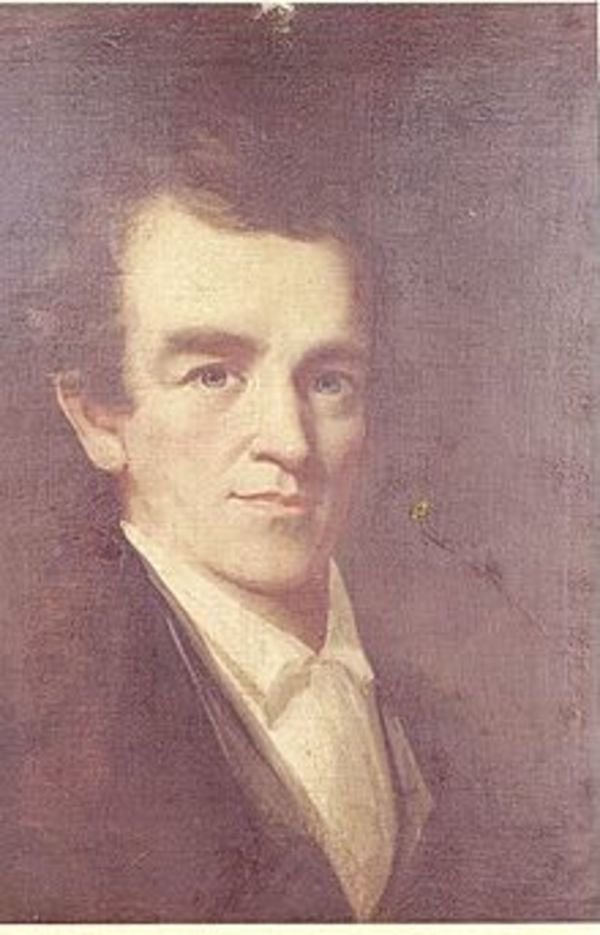
Source: Courtesy of Wikimedia Commons
BOWMAN, JAMES, painter; b. 1793 in Allegheny County, Pa; d. 18 May 1842 in Rochester, N.Y.
James Bowman typifies a number of successful American portrait painters working as itinerants in the Canadas and in the eastern United States during the 1830s and 1840s. Commencing life as a carpenter in Ohio, he learned the rudiments of painting from a local artist before painting portraits in Pittsburgh, Philadelphia, and Washington. From 1822 he spent about eight years in Europe, studying in London (under Sir Thomas Lawrence), in Paris, and in Rome. On returning to the United States about 1829, he painted in Charleston, W.Va, and Boston.
Bowman moved to Quebec City in 1831. There he had commissions for portraits of Governor Lord Aylmer [Whitworth-Aylmer), Lady Aylmer, and Marie-Louise de Saint-Henri [McLoughlin] of the Ursulines. In the spring of 1833 he exhibited in Montreal a diorama of the interior of the Capuchin chapel in Rome; that July it appeared in Quebec, the first diorama exhibited there. The Quebec Mercury praised it highly for its startling illusionistic effect, but Antoine Plamondon* criticized it in Le Canadien, claiming that it had “enormous faults” and that it made a “feeble impression.”
While working in Montreal during 1833 and 1834, Bowman continued his portraiture, painting members of the English-speaking establishment. Soon after his arrival in 1833, he painted a view of the Sulpician mission at Lac-des-Deux-Montagnes (Oka) which depicted priests, including Joseph-Vincent Quiblier*, distributing presents from the pope to some 70 Indians. That year Quiblier commissioned Bowman to produce six paintings for the side chapels of the new church of Notre-Dame in Montreal. After accomplishing this task, Bowman was asked to execute for Notre-Dame 14 paintings representing the Stations of the Cross, in which he would be assisted by his pupil Thomas-Henri Valin. With only four of these completed, Bowman abandoned the project in 1834 and moved to Toronto. Plamondon took on the assignment in 1836, at the same time writing to Quiblier that Bowman’s four Stations were bad and that they had gone to hang “in dark corridors” of the Ursuline convent in Quebec (they have since been lost). Of Bowman’s six original paintings commissioned for the church, only two (Le Christ désignant saint Roch comme patron contre la peste and L’éducation de la Vierge) are preserved.
Much acclaim was heaped on Bowman by the Toronto Patriot, a conservative newspaper, after he moved there in October 1834. His sitters, described as the local “Gentry,” were leading family-compact supporters. Perhaps these portraits were regarded as having a certain propaganda value at a time when William Lyon Mackenzie* was championing reform in Upper Canada. A subscription was set up to commission a portrait of the lieutenant governor, Sir John Colborne*. Portraits were painted of Allan Napier MacNab*, MacNab’s mother-in-law (described as in Sir Thomas Lawrence’s style), various MacNab family members, Colborne’s son, judge Levius Peters Sherwood, John Strachan*, William Dunlop, and others. The Patriot praised Bowman’s paintings as the “best pictures that have ever been exhibited in this country,” and described him as a “fine subject for moral reflection; he was literally a Backwoods-man of America, and, in the recesses of the forest, became fired with the noble ambition to rival the first in the Arts.” The youthful Paul Kane* was swept up by Bowman’s enthusiasm and arranged to go to Europe with him for study; plans were altered following Bowman’s marriage, and Kane went overseas alone in 1841.
Bowman had left Toronto in 1835. The following year he married Julia M. Chew in Detroit and then painted in several American cities before opening a studio in Rochester, N.Y., in October 1841. There he struck up a brief but close friendship with Cornelius Krieghoff*, then working in that city. Krieghoff copied Bowman’s most noted portrait, that of Danish sculptor Bertel Thorvaldsen. Bowman died suddenly in May 1842. The following year Krieghoff held an exhibition of his own paintings, proposing to use any proceeds to erect a memorial to Bowman, who had undoubtedly inspired all younger artists with whom he came in contact.
L’Ami du peuple, de l’ordre et des lois, 11 oct. 1834. Le Canadien, 24 juill. 1833. Patriot (Toronto), 21, 28, 31 Oct., 7 Nov., 5, 23 Dec. 1834; 16 Jan. 1835. Le Populaire, 23 oct. 1837. Quebec Gazette, 30 Sept. 1831, 2 Jan. 1832, 15 July 1833. Quebec Mercury, 13 July 1833. Rochester Daily Advertiser (Rochester, N.Y.), 19 May 1842, 30 May 1843. Rochester Daily Democrat, 1 June 1842. Rochester Evening Post, 18 May 1842. G. C. Groce and D. H. Wallace, The New-York Historical Society’s dictionary of artists in America, 1564–1860 (New Haven, Conn., and London, 1957; repr. 1964). Harper, Early painters and engravers. Maurault, La paroisse: hist. de Notre-Dame de Montréal (1929), 114, 163. Morisset, Coup d’œil sur les arts, 80–81; Peintres et tableaux, 2: 82; La peinture traditionnelle, 138. Paul Kane’s frontier; including “Wanderings of an artist among the Indians of North America” by Paul Kane, ed. and intro. J. R. Harper (Toronto, 1971). Yves Lacasse, “La contribution du peintre américain James Bowman (1793–1842) au premier décor intérieur de l’église Notre-Dame de Montréal,” Journal of Canadian Art Hist. (Montreal), 7 (1983–84): 74–91.
J. Russell Harper, “BOWMAN, JAMES (1793-1842),” in Dictionary of Canadian Biography, vol. 7, University of Toronto/Université Laval, 2003–, accessed November 28, 2024, http://www.biographi.ca/en/bio/bowman_james_1793_1842_7E.html.
The citation above shows the format for footnotes and endnotes according to the Chicago manual of style (16th edition). Information to be used in other citation formats:
| Permalink: | http://www.biographi.ca/en/bio/bowman_james_1793_1842_7E.html |
| Author of Article: | J. Russell Harper |
| Title of Article: | BOWMAN, JAMES (1793-1842) |
| Publication Name: | Dictionary of Canadian Biography, vol. 7 |
| Publisher: | University of Toronto/Université Laval |
| Year of publication: | 1988 |
| Year of revision: | 1988 |
| Access Date: | November 28, 2024 |